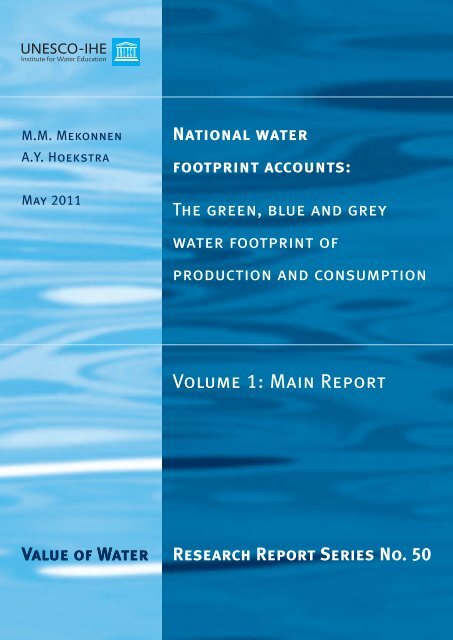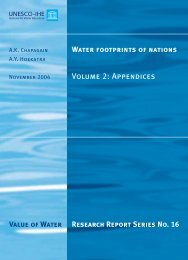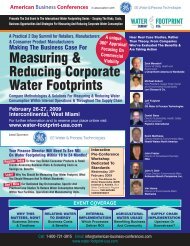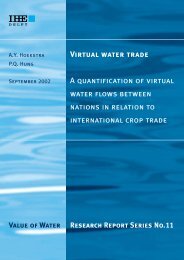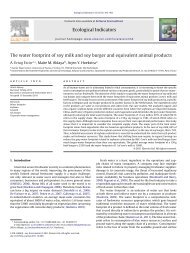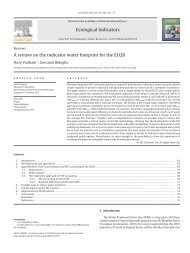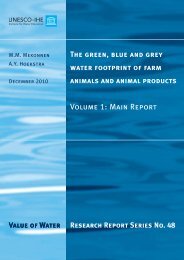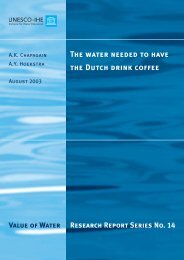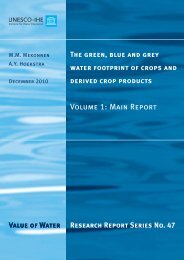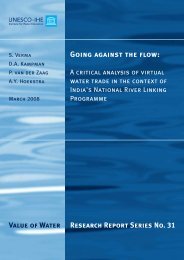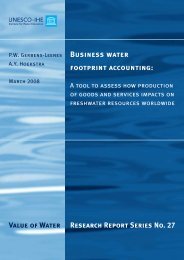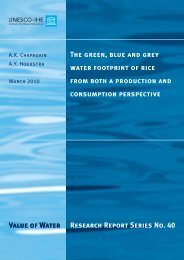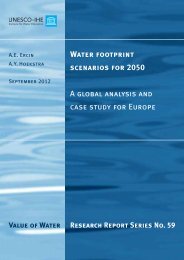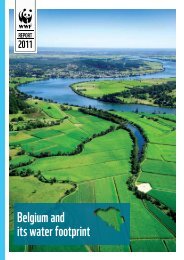Mekonnen and Hoekstra (2011) - Water Footprint Network
Mekonnen and Hoekstra (2011) - Water Footprint Network
Mekonnen and Hoekstra (2011) - Water Footprint Network
- No tags were found...
You also want an ePaper? Increase the reach of your titles
YUMPU automatically turns print PDFs into web optimized ePapers that Google loves.
M.M. <strong>Mekonnen</strong>A.Y. <strong>Hoekstra</strong>May <strong>2011</strong>National waterfootprint accounts:The green, blue <strong>and</strong> greywater footprint ofproduction <strong>and</strong> consumptionVolume 1: Main ReportValue of <strong>Water</strong>Research Report Series No. 50
NATIONAL WATER FOOTPRINT ACCOUNTS:THE GREEN, BLUE AND GREY WATER FOOTPRINTOF PRODUCTION AND CONSUMPTIONVOLUME 1: MAIN REPORTM.M. MEKONNEN 1A.Y. HOEKSTRA 1,2MAY <strong>2011</strong>VALUE OF WATER RESEARCH REPORT SERIES NO. 501 Twente <strong>Water</strong> Centre, University of Twente, Enschede, The Netherl<strong>and</strong>s2 Contact author: Arjen Y. <strong>Hoekstra</strong>, a.y.hoekstra@utwente.nl
© <strong>2011</strong> M.M. <strong>Mekonnen</strong> <strong>and</strong> A.Y. <strong>Hoekstra</strong>.Published by:UNESCO-IHE Institute for <strong>Water</strong> EducationP.O. Box 30152601 DA DelftThe Netherl<strong>and</strong>sThe Value of <strong>Water</strong> Research Report Series is published by UNESCO-IHE Institute for <strong>Water</strong> Education, incollaboration with University of Twente, Enschede, <strong>and</strong> Delft University of Technology, Delft.All rights reserved. No part of this publication may be reproduced, stored in a retrieval system, or transmitted, inany form or by any means, electronic, mechanical, photocopying, recording or otherwise, without the priorpermission of the authors. Printing the electronic version for personal use is allowed.Please cite this publication as follows:<strong>Mekonnen</strong>, M.M. <strong>and</strong> <strong>Hoekstra</strong>, A.Y. (<strong>2011</strong>) National water footprint accounts: the green, blue <strong>and</strong> grey waterfootprint of production <strong>and</strong> consumption, Value of <strong>Water</strong> Research Report Series No. 50, UNESCO-IHE, Delft,the Netherl<strong>and</strong>s.
ContentsSummary ................................................................................................................................................................. 51. Introduction ........................................................................................................................................................ 72. Method <strong>and</strong> data ............................................................................................................................................... 112.1. Accounting framework ............................................................................................................................ 112.2. <strong>Water</strong> footprints of national production ................................................................................................... 122.3. International virtual water flows .............................................................................................................. 122.4. National <strong>and</strong> global water savings related to international trade ............................................................. 132.5. <strong>Water</strong> footprints of national consumption ............................................................................................... 133. Results .............................................................................................................................................................. 173.1. The water footprint of national production .............................................................................................. 173.2. International virtual water flows related to trade in agricultural <strong>and</strong> industrial products ........................ 203.3. National water saving per country as a result of trade ............................................................................. 223.4. Global water saving related to trade in agricultural <strong>and</strong> industrial products ............................................ 233.5. The water footprint of national consumption ........................................................................................... 253.6. External water dependency of countries .................................................................................................. 283.7. Mapping the global water footprint of national consumption: an example from the US ......................... 324. Discussion ........................................................................................................................................................ 375. Conclusion ........................................................................................................................................................ 39References ............................................................................................................................................................. 41Appendices……..…………………………………………………………………………………………Volume 2
SummaryThis study quantifies <strong>and</strong> maps the water footprints of nations from both a production <strong>and</strong> consumptionperspective <strong>and</strong> estimates international virtual water flows <strong>and</strong> national <strong>and</strong> global water savings as a result oftrade. The entire estimate includes a breakdown of water footprints, virtual water flows <strong>and</strong> water savings intotheir green, blue <strong>and</strong> grey components. The main finding of the study can be summarized as:The global water footprint in the period 1996-2005 was 9087 Gm 3 /yr (74% green, 11% blue, 15% grey).Agricultural production contributes 92% to this total footprint.About one fifth of the global water footprint relates to production for export.The total volume of international virtual water flows related to trade in agricultural <strong>and</strong> industrial productswas 2320 Gm 3 /yr (68% green, 13% blue, 19% grey). Trade in crop products contributes 76% to the totalvolume of international virtual water flows; trade in animal <strong>and</strong> industrial products contribute 12% each. Asa global average, the blue <strong>and</strong> grey shares in the total water footprint of internationally traded products areslightly larger than in the case of domestically consumed products.Mexico <strong>and</strong> Spain are the two countries with the largest national blue water savings as a result of trade.The global water saving as a result of trade in agricultural products in the period 1996-2005 was 369 Gm 3 /yr(59% green, 27% blue, 15% grey), which is equivalent to 4% of the global water footprint related toagricultural production. The global blue water saving is equivalent to 10% of the global blue water footprintrelated to agricultural production, which indicates that virtual water importing countries generally dependmore strongly on blue water for crop production than the virtual water exporting countries. The largest globalwater saving (53%) is due to trade in cereal crops, followed by oil crops (22%) <strong>and</strong> animal products (15%).International trade in industrial products can be associated with an increased global water footprint that isequivalent to 4% of the global water footprint related to industrial production.The water footprint of the global average consumer in the period 1996-2005 was 1385 m 3 /yr. About 92% ofthe water footprint is related to the consumption of agricultural products, 5% to the consumption ofindustrial goods, <strong>and</strong> 4% to domestic water use.The average consumer in the US has a water footprint of 2842 m 3 /yr, while the average citizens in China<strong>and</strong> India have water footprints of 1071 m 3 /yr <strong>and</strong> 1089 m 3 /yr respectively.Consumption of cereal products gives the largest contribution to the water footprint of the average consumer(27%), followed by meat (22%) <strong>and</strong> milk products (7%). The contribution of different consumptioncategories to the total water footprint varies across countries.The volume <strong>and</strong> pattern of consumption <strong>and</strong> the water footprint per ton of product of the products consumedare the main factors determining the water footprint of a consumer.The study illustrates the global dimension of water consumption <strong>and</strong> pollution by showing that several countriesheavily rely on water resources elsewhere (for example Mexico depending on virtual water imports from the US)<strong>and</strong> that many countries have significant impacts on water consumption <strong>and</strong> pollution elsewhere (for exampleJapan <strong>and</strong> many European countries due to their large external water footprints).
1. IntroductionThe earth’s freshwater resources are subject to increasing pressure in the form of consumptive water use <strong>and</strong>pollution (Postel, 2000; WWAP, 2003, 2006, 2009). Until recently, issues of freshwater availability, use <strong>and</strong>management have been addressed at a local, national <strong>and</strong> river basin scale. The recognition that freshwaterresources are subject to global changes <strong>and</strong> globalization have led a number of researchers to argue for theimportance of putting freshwater issues in a global context (Postel et al., 1996; Vörösmarty et al., 2000; <strong>Hoekstra</strong><strong>and</strong> Hung, 2005; <strong>Hoekstra</strong> <strong>and</strong> Chapagain, 2008; Hoff, 2009). Appreciating the global dimension of freshwaterresources can be regarded as a key to solving some of today’s most urgent water problems (<strong>Hoekstra</strong>, <strong>2011</strong>).In formulating national water plans, governments have traditionally taken a purely national perspective, aimingat matching national water supplies to national water dem<strong>and</strong>s. Governments have looked for ways to satisfywater users without questioning the total amount of water dem<strong>and</strong>s. Even though governments nowadaysconsider options to reduce water dem<strong>and</strong>s, in addition to options to increase supplies, they generally do notconsider the global dimension of water dem<strong>and</strong> patterns. Since production processes in a global economy canshift from one place to another, water dem<strong>and</strong>s can be met outside the boundaries of a nation through the importof commodities. All countries trade water-intensive commodities, but few governments explicitly consideroptions to save water through import of water-intensive products or to make use of relative water abundance toproduce water-intensive commodities for export. In addition, by looking at water use within only their owncountry, governments do not have a comprehensive view of the sustainability of national consumption. Manycountries have significantly externalized their water footprint without looking at whether the imported productsare related to water depletion or pollution in the producing countries. Knowledge of the dependency on waterresources elsewhere is relevant for a national government, not only when evaluating its environmental policy butalso when assessing national food security.Underst<strong>and</strong>ing the water footprint of a nation is highly relevant for developing well-informed national policy.Conventional national water use accounts are restricted to statistics on water withdrawals within their ownterritory (Van der Leeden et al., 1990; Gleick, 1993; FAO, 2010b). National water footprint accounts extendthese statistics by including data on green water use <strong>and</strong> volumes of water use for waste assimilation <strong>and</strong> byadding data on water use in other countries for producing imported products as well as data on water use withinthe country for making export products (<strong>Hoekstra</strong> et al., <strong>2011</strong>).Quantifying <strong>and</strong> mapping ‘national water footprints’ is an evolving field of study since the introduction of thewater footprint concept in the beginning of this century (<strong>Hoekstra</strong>, 2003). The first global study on the waterfootprints of nations was carried out by <strong>Hoekstra</strong> <strong>and</strong> Hung (2002); a second, much more comprehensive study,was done by <strong>Hoekstra</strong> <strong>and</strong> Chapagain <strong>and</strong> reported in a number of subsequent publications: Chapagain <strong>and</strong><strong>Hoekstra</strong> (2004, 2008), Chapagain et al. (2006) <strong>and</strong> <strong>Hoekstra</strong> <strong>and</strong> Chapagain (2007a, 2008). The current study isthe third global assessment of national water footprints, which improves upon the previous assessments in anumber of respects as will be elaborated below.
8 / National water footprint accountsThe objective of this study is to estimate the water footprints of nations from both a production <strong>and</strong> consumptionperspective. First, we quantify <strong>and</strong> map at a high spatial resolution the green, blue <strong>and</strong> grey water footprintswithin countries associated with agricultural production, industrial production <strong>and</strong> domestic water supply.Second, we estimate international virtual water flows related to trade in agricultural <strong>and</strong> industrial commodities.Based on these flows, we estimate national <strong>and</strong> global water savings that can be associated with these tradeflows. Finally, we quantify <strong>and</strong> map the water footprint of consumption for all countries of the worlddistinguishing for each country between the internal <strong>and</strong> the external water footprint of national consumption.Throughout the study we explicitly distinguish between green, blue <strong>and</strong> grey water footprints.The current study is more comprehensive <strong>and</strong> detailed than the earlier two global water footprint studies(<strong>Hoekstra</strong> <strong>and</strong> Hung, 2002; <strong>Hoekstra</strong> <strong>and</strong> Chapagain, 2008). It is also more comprehensive than thecontemporary study by Fader et al. (<strong>2011</strong>), who estimate the global green <strong>and</strong> blue water footprint ofconsumption showing the internal <strong>and</strong> external water footprint per country. This study excludes the grey waterfootprint component <strong>and</strong> is restricted to an analysis of the water footprint of consuming crop products, leavingout the water footprints of farm animal products, industrial products <strong>and</strong> domestic water supply.Apart from the global water footprint studies mentioned, several water footprint studies with a focus on aspecific country were published in the past few years: Vincent et al. (<strong>2011</strong>) for Belgium; Ma et al. (2006), Liu<strong>and</strong> Savenije (2008), Hubacek et al. (2009) <strong>and</strong> Zhao et al. (2009) for China; Sonnenberg et al. (2009) forGermany; Kampman et al. (2008) for India; Bulsink et al. (2009) for Indonesia; <strong>Hoekstra</strong> <strong>and</strong> Chapagain (2007b)for Morocco; <strong>Hoekstra</strong> <strong>and</strong> Chapagain (2007b) <strong>and</strong> Van Oel et al. (2009) for the Netherl<strong>and</strong>s; Aldaya et al.(2010) <strong>and</strong> Garrido et al. (2010) for Spain; Sonnenberg et al. (2010) for Switzerl<strong>and</strong>; Chahed et al. (2008) forTunisia; <strong>and</strong> Chapagain <strong>and</strong> Orr (2008), Yu et al. (2010) <strong>and</strong> Feng et al. (<strong>2011</strong>) for the UK. The scope,assumptions <strong>and</strong> data sources in these country studies vary widely, so these studies cannot be used to makecomparisons between countries.The current study is a global study that allows a comparison of the water footprints of different countries,because the same method, assumptions <strong>and</strong> databases are applied for all countries. The study improves upon theprevious global water footprint study – <strong>Hoekstra</strong> <strong>and</strong> Chapagain (2008) – in a number of respects:We apply a high spatial resolution in estimating the water footprint in crop production, industrial production<strong>and</strong> domestic water supply.In the case of crop production, we make an explicit distinction between the green <strong>and</strong> blue water footprint. Inaddition, we include the grey water footprint in the estimation of the water footprint in agriculturalproduction.We account for actual irrigation, so we do not take irrigation requirements as a proxy for blue waterconsumption.We make use of better estimates of the feed composition of farm animals (which is relevant for theestimation of the water footprint of farm animal products).
National water footprint accounts / 9We distinguish three different animal production systems (grazing, mixed <strong>and</strong> industrial) in each country,accounting for the relative presence of those three systems.We explicitly distinguish between the blue <strong>and</strong> grey water footprint in industrial production <strong>and</strong> domesticwater supply <strong>and</strong> account for wastewater treatment coverage per country.We apply the bottom-up approach in estimating the water footprint of national consumption of agriculturalproducts, which is less sensitive to trade data than the top-down approach.We add calculations of national <strong>and</strong> global water savings related to trade in industrial products. We consider a ten-year period (1996-2005), while the earlier study analysed a five-year period (1997-2001).The current report builds on two earlier studies by the same authors. In <strong>Mekonnen</strong> <strong>and</strong> <strong>Hoekstra</strong> (2010b, <strong>2011</strong>)we have reported the green, blue <strong>and</strong> grey water footprints of crops <strong>and</strong> derived crop products. In <strong>Mekonnen</strong> <strong>and</strong><strong>Hoekstra</strong> (2010c) we documented the green, blue <strong>and</strong> grey water footprints of farm animals <strong>and</strong> animal products.
2. Method <strong>and</strong> data2.1. Accounting frameworkIn this study we adopt the terminology <strong>and</strong> calculation methodology as set out in The <strong>Water</strong> <strong>Footprint</strong>Assessment Manual, which contains the global st<strong>and</strong>ard for water footprint assessment developed by the <strong>Water</strong><strong>Footprint</strong> <strong>Network</strong> (<strong>Hoekstra</strong> et al., <strong>2011</strong>). The ‘water footprint’ is a measure of human’s appropriation offreshwater resources. Freshwater appropriation is measured in terms of water volumes consumed (evaporated orincorporated into a product) or polluted per unit of time. A water footprint has three components: green, blue <strong>and</strong>grey. The blue water footprint refers to consumption of blue water resources (surface <strong>and</strong> ground water). Thegreen water footprint is the volume of green water (rainwater) consumed, which is particularly relevant in cropproduction. The grey water footprint is an indicator of the degree of freshwater pollution <strong>and</strong> is defined as thevolume of freshwater that is required to assimilate the load of pollutants based on existing ambient water qualityst<strong>and</strong>ards. The water footprint is a geographically explicit indicator, showing not only volumes of waterconsumption <strong>and</strong> pollution, but also the locations.Internal waterfootprint ofnationalconsumption+External waterfootprint ofnationalconsumption=<strong>Water</strong> footprintof nationalconsumption+ + +Virtual waterexport relatedto domesticallymade products+Virtual waterre-export=Virtual waterexport= = =<strong>Water</strong> footprintwithin the areaof the nation+Virtual waterimport=Virtual waterbudgetFigure 1. The national water footprint accounting scheme. Source: <strong>Hoekstra</strong> et al. (<strong>2011</strong>).The framework for national water footprint accounting is shown in Figure 1. One can see that ‘the waterfootprint of national consumption’ is different from ‘the water footprint within the area of the nation’. The latteris the water footprint of national production, defined as the total freshwater volume consumed or polluted withinthe territory of the nation as a result of activities within the different sectors of the economy. It can be calculatedby summing the water footprints of all water consuming or polluting processes taking place in the nation.Generally, one can distinguish three main water using sectors: the agricultural sector, the industrial sector <strong>and</strong>the domestic water supply sector. On the other h<strong>and</strong>, the water footprint of national consumption is defined asthe total volume of freshwater that is used to produce the goods <strong>and</strong> services consumed by the inhabitant of thenation. It consists of two components: the internal <strong>and</strong> external water footprint of national consumption. Theinternal water footprint is defined as the use of domestic water resources to produce goods <strong>and</strong> services
12 / National water footprint accountsconsumed by the nation’s population. It is the sum of the water footprint within the nation minus the volume ofvirtual-water export to other nations related to the export of products produced with domestic water resources.The external water footprint is defined as the volume of water resources used in other nations to produce goods<strong>and</strong> services consumed by the population in the nation under consideration. It is equal to the virtual-water importinto the nation minus the volume of virtual-water export to other nations as a result of re-export of importedproducts. The virtual-water export from a nation consists of exported water of domestic origin <strong>and</strong> re-exportedwater of foreign origin. The virtual-water import into a nation will partly be consumed, thus constituting theexternal water footprint of national consumption, <strong>and</strong> may partly be re-exported. The sum of the virtual waterimport into a country <strong>and</strong> the water footprint within the area of the nation is equal to the sum of the virtual waterexport from the nation <strong>and</strong> the water footprint of national consumption. This sum is called the virtual-waterbudget of a nation.2.2. <strong>Water</strong> footprints of national productionThe water footprints within nations related to crop production were obtained from <strong>Mekonnen</strong> <strong>and</strong> <strong>Hoekstra</strong>(2010a, 2010b, <strong>2011</strong>), who estimated the global water footprint of crop production with a crop water use modelat a 5 by 5 arc minute spatial resolution. The water footprints within nations related to water use in livestockfarming, were obtained from <strong>Mekonnen</strong> <strong>and</strong> <strong>Hoekstra</strong> (2010c). The water footprints within nations related toindustrial production <strong>and</strong> domestic water supply were estimated in this study using water withdrawal data fromthe AQUASTAT database (FAO, 2010b). For some countries, water withdrawal data were taken fromEUROSTAT (<strong>2011</strong>). We have assumed that 5% of the water withdrawn for industrial purposes is actualconsumption (blue water footprint) <strong>and</strong> that the remaining fraction is return flow; for the domestic water supplysector we assumed a consumptive portion of 10% (FAO, 2010b). The part of the return flow which is disposedinto the environment without prior treatment has been taken as a measure of the grey water footprint, thusassuming a dilution factor of 1. Data on the wastewater treatment coverage per country were obtained from theUnited Nations Statistical Division database (UNSD, 2010a). For countries for which we could not find data, weassumed zero wastewater treatment coverage. Domestic wastewater treatment coverage data are generallyspecified for urban areas only; we used data on urban populations per country from FAO (2010a) to estimate thegrey water footprint from domestic water supply in urban areas. For rural areas we assumed zero treatment. Fortreatment coverage in the industrial sector per country we used data on municipal treatment coverage in urbanareas as an indicator. <strong>Water</strong> footprints related to industrial production <strong>and</strong> domestic water supply were mappedusing the global population density map from CIESIN <strong>and</strong> CIAT (2005).2.3. International virtual water flowsInternational virtual-water flows are calculated by multiplying, per trade commodity, the volume of trade by therespective average water footprint per ton of product in the exporting nation. When a product is exported from acountry that does not produce the product we have assumed the global average product water footprint for thattrade flow.
National water footprint accounts / 13Data on international trade in agricultural <strong>and</strong> industrial products have been taken from the SITA database(Statistics for International Trade Analysis) available from the International Trade Centre (ITC, 2007). Thisdatabase covers trade data over ten years (1996-2005) from 230 reporting countries disaggregated by product<strong>and</strong> partner countries. Country-specific estimates on the green, blue <strong>and</strong> grey water footprints of 146 crops <strong>and</strong>more than two hundred derived crop products per ton of product were taken from <strong>Mekonnen</strong> <strong>and</strong> <strong>Hoekstra</strong>(2010b). Estimates on the water footprints of farm animals (beef cattle, dairy cattle, pig, sheep, goat, broilerchicken, layer chicken <strong>and</strong> horses) <strong>and</strong> animal products per ton of product were taken from <strong>Mekonnen</strong> <strong>and</strong><strong>Hoekstra</strong> (2010c). The national average water footprint per dollar of industrial product was calculated percountry by dividing the total national water footprint in the industrial sector by the value added in industrialsector. The latter was obtained from the United Nations Statistical Division database (UNSD, 2010b).2.4. National <strong>and</strong> global water savings related to international tradeThe national water saving of a country as a result of trade in a certain commodity is calculated as the net importvolume of this commodity times the water footprint of the commodity per commodity unit in the countryconsidered. Obviously, the calculated saving can have a negative sign, which means a net national water lossinstead of a saving. The global water saving through trade in a commodity between two countries is calculated asthe trade volume times the difference between the water footprints of the commodity per unit of the commodityin the importing <strong>and</strong> the exporting country. The total global water saving is obtained by summing up the globalsavings of all international trade flows. By definition, the total global water saving is equal to the sum of thenational savings of all nations.2.5. <strong>Water</strong> footprints of national consumptionThe water footprint of national consumption (in m 3 /yr) is calculated by adding the direct water footprint ofconsumers <strong>and</strong> two indirect water footprint components:WF WF WF ( agricultural commodities) WF ( industrial commodities)(1)cons cons, dir cons, indir cons,indirThe direct water footprint of consumers within the nation (WF cons,dir ) refers to consumption <strong>and</strong> pollution ofwater related to domestic water supply. The indirect water footprint of consumers (WF cons,indir ) refers to the wateruse by others to make the commodities consumed, whereby we distinguish between agricultural <strong>and</strong> industrialcommodities.The water footprint of national consumption of agricultural <strong>and</strong> industrial commodities can be calculated througheither the top-down or the bottom-up approach (<strong>Hoekstra</strong> et al., <strong>2011</strong>). In the top-down approach, the waterfootprint of national consumption is calculated as the water footprint within the nation plus the virtual-waterimport minus the virtual-water export. The gross virtual-water import is calculated by multiplying importvolumes of various products by their respective product water footprint in the nation of origin. The gross virtualwaterexport is found by multiplying the export volumes of the various export products by their respective
14 / National water footprint accountsproduct water footprint. In the bottom-up approach, the water footprint of national consumption is calculated byadding the direct <strong>and</strong> indirect water footprints of consumers within the nation.For agricultural commodities, the water footprint of national consumption is calculated in this study based on thebottom-up approach. It is calculated by multiplying all agricultural products consumed by the inhabitants of thenation by their respective product water footprint:WFcons, indir ( agricultural commodities) ( C[ p] WFprod[ p])(2)pC[p] is consumption of agricultural product p by consumers within the nation (ton/yr) <strong>and</strong> WF* prod [p] the waterfootprint of this product (m 3 /ton). We consider the full range of final agricultural goods. Data on nationalconsumption of agricultural products per country for the period 1996-2005 were taken from the Supply <strong>and</strong>Utilization Accounts (SUA) of the Food <strong>and</strong> Agriculture Organization of the United Nations (FAO, 2010a). Foredible products, we have taken the “food” column multiplied by a certain factor representing seed <strong>and</strong> waste. Forfibre, hide <strong>and</strong> skin products, we took the “other utilization” column, again multiplied by a certain factorrepresenting seed <strong>and</strong> waste. The multiplication factor was calculated per product as the global productiondivided by the difference between the global production <strong>and</strong> volume of seed <strong>and</strong> waste.The volume of agricultural product p consumed in a nation will generally originate in part from the nation itself<strong>and</strong> in part from other nations. The average water footprint of a product p consumed in a nation is:WFprodP[p]WFprod[ p]nT [ n , p]WFe[ p](3)P[p] T [ n , p]neiieeprode[ n , p]in which P[p] represents the production quantity of product p in the nation, T i [n e ,p] the imported quantity ofproduct p from exporting nation n e , WF prod [p] the water footprint of product p when produced in the nationconsidered <strong>and</strong> WF prod [n e ,p] the water footprint of product p as in the exporting nation n e . The assumption madehere is that the total consumption volume originates from domestic production <strong>and</strong> imports according to theirrelative volumes. The water footprints of agricultural products were taken from <strong>Mekonnen</strong> <strong>and</strong> <strong>Hoekstra</strong> (2010b,2010c).For industrial commodities, the water footprint of national consumption is calculated based on the top-downapproach as the water footprint of industrial processes taking place within the nation plus the virtual-waterimport related to import of industrial commodities minus the virtual-water export.The external water footprint of national consumption (WF cons,ext ) is estimated based on the relative share of thevirtual water import to the total water budget:
National water footprint accounts / 15WFcons,extViWF VareaiWFcons(4)in which WF area is the water footprint within a nation <strong>and</strong> V i the virtual water import. We apply this formulaseparately for the category of agricultural products (crop <strong>and</strong> animal products) <strong>and</strong> for the category of theindustrial products. The internal water footprint of national consumption (WF cons,int ) is calculated as:WFcons,intWFWFareaareaWFVicons(5)For mapping the global water footprint of the consumption of a certain country at a high spatial resolution, wedistinguish between mapping the internal <strong>and</strong> the external water footprint. The internal water footprint is mappedby taking the shares of the water footprints within the different grid cells in the country that contribute to thewater footprint of national consumption. Mapping the external water footprint is done in two steps. First, wequantify the external water footprint per product category per trade partner country based on the relative importfrom different trade partners. Second, within each trade partner country we map the external water footprint bytaking the shares of the water footprints within the different grid cells in the trade partner country that contributeto the water footprint of consumption in our country under consideration. We could not trace the external waterfootprint of imported animal products at grid level because of data limitations.In a case study for the US, we applied the above approach but took a more refined, though laborious, approachby applying the whole procedure separately for each crop type <strong>and</strong> animal type. For (domestically produced <strong>and</strong>consumed) animal products we identify the feed volumes from the country itself <strong>and</strong> from abroad, <strong>and</strong> for eachfeed crop we map the internal <strong>and</strong> external water footprints using the same approach as for food crops. Thecategory of the industrial products was still treated as one category. The mapping of the external water footprintis slightly improved this way, but more importantly, it enabled us to trace the external water footprint not only bylocation but also by crop.
3. Results3.1. The water footprint of national productionFigure 2 shows world maps with the green, blue <strong>and</strong> grey water footprints within nations in the period 1996-2005. China, India <strong>and</strong> the US are the countries with the largest total water footprints within their territory, withtotal water footprints of 1207, 1182 <strong>and</strong> 1053 Mm 3 /yr, respectively. About 38% of the water footprint of globalproduction lies within these three countries. The next country in the ranking is Brazil, with a total water footprintwithin its territory of 482 Mm 3 /yr. India is the country with the largest blue water footprint within its territory:243 Mm 3 /yr, which is 24% of the global blue water footprint. Irrigation of wheat is the process that takes thelargest share (33%) in India’s blue water footprint, followed by irrigation of rice (24%) <strong>and</strong> irrigation ofsugarcane (16%). China is the country with the largest grey water footprint within its borders: 360 Mm 3 /yr,which is 26% of the global grey water footprint.Figure 3 shows world maps with the water footprints of agricultural production, industrial production <strong>and</strong> relatedto domestic water supply. In all countries of the world, the water footprint related to agricultural production takesthe largest share in the total water footprint within the country. China <strong>and</strong> the US have the largest waterfootprints in their territory related to industrial production; 22% of the global water footprint related to industrialproduction lies in China <strong>and</strong> 18% in the US. Belgium is the country in which industrial production takes thelargest share in the total water footprint in the country. The water footprint of industries in Belgium contributes41% to the total water footprint in the country; agricultural production still contributes 53% here. Full statisticson the green, blue <strong>and</strong> grey water footprints related to agricultural <strong>and</strong> industrial production <strong>and</strong> domestic watersupply per country are provided in Appendix I.The global water footprint related to agricultural <strong>and</strong> industrial production <strong>and</strong> domestic water supply for theperiod 1996-2005 was 9087 Gm 3 /yr (74% green, 11% blue, 15% grey; see Table 1). Agricultural productiontakes the largest share, accounting for 92% of the global water footprint. Industrial production contributes 4.4%to the total water footprint <strong>and</strong> domestic water supply 3.6%.The global water footprint related to producing goods for export is 1762 Gm 3 /yr. In the agricultural sector, 19%of the total water footprint relates to production for export; in the industrial sector this is 41%. The waterfootprint related to domestic water supply does not relate to export at all. Taken as an average over the threewater-using sectors, we find that 19% of the global water footprint is not for domestic consumption but forexport.
18 / National water footprint accountsFigure 2. The green, blue <strong>and</strong> grey water footprints within nations in the period 1996-2005. The data are shown inmm/yr on a 5 by 5 arc minute grid. Data per grid cell have been calculated as the water footprint within a grid cell(in m 3 /yr) divided by the area of the grid cell (in 10 3 m 2 ).
National water footprint accounts / 19Figure 3. The water footprint within nations in the period 1996-2005, shown by sector: the total water footprint ofagricultural production (above), the total water footprint of industrial production (middle) <strong>and</strong> the total waterfootprint related to domestic water supply (below). The data are shown in mm/yr on a 5 by 5 arc minute grid. Dataper grid cell have been calculated as the water footprint within a grid cell (in m 3 /yr) divided by the area of the gridcell (in 10 3 m 2 ).
20 / National water footprint accountsTable 1. Global water footprint of production (1996-2005).CropproductionAgricultural productionPasture<strong>Water</strong> supplyin animalraisingIndustrialproductionDomesticwatersupplyTotalGlobal water footprint ofproduction (Gm 3 /yr)- Green 5771* 913** - - - 6684- Blue 899* - 46** 38 42 1025- Grey 733* - - 363 282 1378- Total 7404 913 46 400 324 9087<strong>Water</strong> footprint for export(Gm 3 /yr)<strong>Water</strong> footprint for exportcompared to total (%)- - - - - - - - - - - - - - - - 1597 - - - - - - - - - - - - - - - - 165 0 1762- - - - - - - - - - - - - - - - - - 19 - - - - - - - - - - - - - - - - - 41 0 19* Source: <strong>Mekonnen</strong> <strong>and</strong> <strong>Hoekstra</strong> (2010b; <strong>2011</strong>).** Source: <strong>Mekonnen</strong> <strong>and</strong> <strong>Hoekstra</strong> (2010c).3.2. International virtual water flows related to trade in agricultural <strong>and</strong> industrial productsThe global sum of international virtual water flows for the period 1996-2005 was 2320 Gm 3 /yr (68% green, 13%blue <strong>and</strong> 19% grey). The largest share (76%) of the virtual water flows between countries is related tointernational trade in crops <strong>and</strong> derived crop products. Trade in animal products <strong>and</strong> industrial productscontributed 12% each to the global virtual water flows. The volume of global virtual water flows related todomestically produced products was 1762 Gm 3 /yr. The gross international virtual water flows are presented inTable 2. Appendix II tabulates the virtual water flows per country.Table 2. Gross international virtual water flows (Gm 3 /yr). Period 1996-2005.Related to trade inagricultural productsRelated to trade inindustrial productsTotalRelated to export of domestically produced goods 1597 165 1762Related to re-export of imported goods 441 117 558Total 2038 282 2320As a global average, the blue <strong>and</strong> grey shares in the total water footprint of internationally traded products areslightly larger than in the case of domestically consumed products. This means that export goods are morestrongly related to water consumption from <strong>and</strong> pollution of surface <strong>and</strong> groundwater than non-export goods.The green component in the total water footprint of internationally traded products is 68%, while it is 74% fortotal global production.The major gross virtual water exporters, which together account for more than half of the global virtual waterexport, are the US (314 Gm 3 /yr), China (143 Gm 3 /yr), India (125 Gm 3 /yr), Brazil (112 Gm 3 /yr), Argentina (98Gm 3 /yr), Canada (91 Gm 3 /yr), Australia (89 Gm 3 /yr), Indonesia (72 Gm 3 /yr), France (65 Gm 3 /yr) <strong>and</strong> Germany
National water footprint accounts / 21(64 Gm 3 /yr). The US, Pakistan, India, Australia, Uzbekistan, China <strong>and</strong> Turkey are the largest blue virtual waterexporters, accounting for 49% of the global blue virtual water export. All of these countries are partially underwater stress (Alcamo <strong>and</strong> Henrichs, 2002; Alcamo et al. 2003; Smakhtin et al., 2004). This raises the questionwhether the implicit or explicit choice to consume the limited national blue water resources for export productsis sustainable <strong>and</strong> most efficient. Closely related to this is the question to what extent the scarcity is reflected inthe price of water in these countries. Given the fact that all the externalities <strong>and</strong> a scarcity rent are seldomincluded in the price of water, most particular in agriculture, one cannot expect that production <strong>and</strong> trade patternsautomatically account for regional water scarcity patterns.The major gross virtual water importers are the US (234 Gm 3 /yr), Japan (127 Gm 3 /yr), Germany (125 Gm 3 /yr),China (121 Gm 3 /yr), Italy (101 Gm 3 /yr), Mexico (92 Gm 3 /yr), France (78 Gm 3 /yr), the UK (77 Gm 3 /yr) <strong>and</strong> theNetherl<strong>and</strong>s (71 Gm 3 /yr).Figure 4 shows the virtual water balance per country <strong>and</strong> the largest international gross virtual water flows. Thecountries shown in green colour have a negative balance, which means that they have net virtual water export.The countries shown in yellow to red have net virtual water import. The biggest net exporters of virtual water arefound in North <strong>and</strong> South America (the US, Canada, Brazil <strong>and</strong> Argentina), Southern Asia (India, Pakistan,Indonesia, Thail<strong>and</strong>) <strong>and</strong> Australia. The biggest net virtual water importers are North Africa <strong>and</strong> the Middle East,Mexico, Europe, Japan <strong>and</strong> South Korea.Figure 4. Virtual water balance per country <strong>and</strong> direction of gross virtual water flows related to trade in agricultural<strong>and</strong> industrial products over the period 1996-2005. Only the biggest gross flows (> 15 Gm 3 /yr) are shown; thefatter the arrow, the bigger the virtual water flow.The largest share of the international virtual water flows relates to trade in oil crops (including cotton, soybean,oil palm, sunflower, rapeseed <strong>and</strong> others) <strong>and</strong> derived products. This category accounts for 43% of the total sumof international virtual water flows. More than half of this amount relates to trade in cotton products; about onefifth relates to trade in soybean. The other products with a large share in the global virtual water flows are cereals(17%), industrial products (12.2%), stimulants (7.9%) <strong>and</strong> beef cattle products (6.7%). Figure 5 shows thecontribution of different product categories to the global sum of international virtual water flows. Virtual waterflows per product category are presented in Appendix III.
22 / National water footprint accountsIndustrial products12.2%Cereals17.0%Stimulants7.9%Bovine products6.7%Other6.4%Sugarcrops3.5%Fruits2.0%Milk products1.6%Spices0.7%Poultry0.8%Horse0.5%Nuts0.5% Sheep0.5%Roots <strong>and</strong> Tubers0.3%Tobacco0.2%Other0.5%Oilcrops42.7%Pulses0.8%Swine products1.5%Figure 5. Contribution of different product categories to the global virtual water flows3.3. National water saving per country as a result of tradeA number of countries reduce the use of their national water resources through the import of agriculturalproducts. Japan saves 134 Gm 3 /yr (80% green, 9% blue, 12% grey) of its domestic water resources, Mexico 83Gm 3 /yr (69% green, 26% blue, 6% grey), Italy 54 Gm 3 /yr (83% green, 10% blue, 7% grey), the UK 53 Gm 3 /yr(75% green, 15% blue, 9% grey) <strong>and</strong> Germany 50 Gm 3 /yr (83% green, 14% blue, 3% grey). In terms of bluewater saved, Mexico, Spain, Japan, the UK <strong>and</strong> a number of countries in the Middle East come on top of the list.Appendix IV presents green, blue <strong>and</strong> grey water savings per country as a result of trade in crop, animal <strong>and</strong>industrial products. The figures on ‘national water saving’ presented here should be merely understood as‘volumes of domestic water resources not necessary to be used for production because the commodities areimported’. The term ‘saving’ is used in a physical, not economic sense. Besides, the ‘water saving’ does notnecessarily imply that the water saved is allocated to other beneficial uses (De Fraiture et al. 2004). In waterscarcecountries, however, ‘water saving’ is likely to have positive environmental, social <strong>and</strong> economicimplications.From a water resources point of view, one would expect that countries facing water stress adopt a trade strategythat alleviates their water scarcity problem. However, international trade in agricultural goods is driven largelyby factors other than water. Therefore, import of virtual water is often unrelated to relative water scarcity in acountry (Yang et al., 2003; De Fraiture et al., 2004; Oki <strong>and</strong> Kanae, 2004; Chapagain <strong>and</strong> <strong>Hoekstra</strong>, 2008; Yang<strong>and</strong> Zehnder, 2008). As shown by Yang et al. (2003), only below a certain threshold in water availability can arelationship be established between the country’s per capita water availability <strong>and</strong> its cereal import. For mostrelatively water-scarce countries – like in North Africa, Middle East, Southern Europe <strong>and</strong> Mexico – we findindeed net virtual water imports <strong>and</strong> related national water savings. The national water savings found forNorthern European countries, however, cannot be understood from a water scarcity perspective.
National water footprint accounts / 233.4. Global water saving related to trade in agricultural <strong>and</strong> industrial productsThe global water saving related to trade in agricultural products in the period 1996-2005 was 369 Gm 3 /yr (58.7%green, 26.6% blue <strong>and</strong> 14.7% grey). This volume is equivalent to 4% of the global water footprint related toagricultural production (which is 8363 Gm 3 /yr, see Table 1). Looking only at the blue water saving, it wouldhave required an additional 98 Gm 3 /yr of blue water to produce the same amount of goods without virtual watertrade. This volume is equivalent to 10% of the global blue water footprint related to agricultural production(which is 945 Gm 3 /yr, see again Table 1). More than a quarter (98/369=27%) of the global water saving relatedto agricultural trade is blue water, which indicates that virtual water importing countries generally depend morestrongly on blue water for crop production than the virtual water exporting countries. Figure 6 shows trade flowsthat save more than 5 Gm 3 /yr. Export of agricultural products (mainly maize <strong>and</strong> soybean products) from the USto Mexico <strong>and</strong> Japan comprise the biggest global water savings, contributing over 11% toward the total globalwater saving.The largest water saving is due to trade in cereal crops with a global water saving of 196 Gm 3 /yr, followed by oilcrops (82 Gm 3 /yr, mainly soybean) <strong>and</strong> animal products (56 Gm 3 /yr). Among the cereal crops, trade in maize hasresulted in the largest saving (71 Gm 3 /yr), followed by wheat (67 Gm 3 /yr), rice (27 Gm 3 /yr), barley (21 Gm 3 /yr)<strong>and</strong> other cereals (10 Gm 3 /yr). In the case of rice, there is net global water saving if we look at the sum of green,blue <strong>and</strong> grey, but when we focus on the blue component we find a global blue water loss associated with tradein rice. Among the animal products, international trade in poultry products (25 Gm 3 /yr), dairy products (16Gm 3 /yr), bovine products (16 Gm 3 /yr) <strong>and</strong> pig products (2 Gm 3 /yr) result in significant global water savings, buttrade flows in horse, sheep <strong>and</strong> goat products are accompanied with a total global water loss of 3 Gm 3 /yr. Figure7 shows the contribution of different product groups to the total global water saving.Trade in industrial products has resulted in a net global water loss of 16.4 Gm 3 /yr (2% blue <strong>and</strong> 98% grey). Thisvolume is equivalent to 4% of the global water footprint related to industrial production (which is 400 Gm 3 /yr,see Table 1). Exports of industrial products from China <strong>and</strong> Russia are the major trade flows contributing to thisglobal water loss related to industrial product trade. This is mainly due to the large grey water footprints per unitof value added in the industrial sectors in those two countries, which in turn relate to the low wastewatertreatment coverage in those countries.When we consider the global water saving related to trade in both agricultural <strong>and</strong> industrial products, we cometo a net saving of 353 Gm 3 /yr (61.5% green, 27.7% blue <strong>and</strong> 10.8% grey). The global water saving related totrade in agricultural <strong>and</strong> industrial products is presented in Appendix V. Global water savings due tointernational trade in crop products are specified by crop type; global water savings related to trade in animalproducts are given by animal type.
National water footprint accounts / 2580604020Maize71 Wheat67Rice27Barley21Others1080 Soybeans606040200-20Others212500-40Global water saving (Gm 3 /yr)200150100500196-20825630 Poultry25Cereals Oilcrops Animals products Fruits Other crops20100-1013Dairy1622Bovine16Others-1Industrial-16-50Green Blue GreyFigure 7. Contribution of different product categories to the total global water saving (1996-2005).The calculated trade-related water savings are based on the crop yields <strong>and</strong> corresponding water footprints asthey currently exist in the exporting <strong>and</strong> importing countries. One should therefore be careful in extrapolatingwater savings when trade flows would intensify. <strong>Water</strong> scarcity will stimulate countries to improve their waterproductivities, particularly in countries with low yields (Appelgren <strong>and</strong> Klohn, 1999; Keller et al., 1998; Molle,2003; Ohlsson, 2000). Current global water savings resulting from trade in water-intensive products fromcountries with high water productivity to countries with low water productivity will diminish once the lattercountries have increased their water productivity.The presented global water saving related to international trade may seem significant: the global water footprintof agricultural <strong>and</strong> industrial production would be 4% higher if countries would produce all commodities withintheir own territory based on existing domestic productivities instead of partially import them from othercountries. The potential of optimising international trade for further global water savings is probably small oncethe most important importing countries with low water productivities increase their productivity. The globalwater footprint can be reduced more significantly by achieving high water productivities across the globe than byoptimising trade from high to low productivity regions. Supported by the assessment by Falkenmark et al.(2009), we estimate that the potential global water saving by increasing water productivities in regions thatcurrently still have low productivities will be of an order of magnitude larger than the current global watersaving achieved by trade. Therefore, for water scarce countries the first priority should be to raise their waterproductivity as much as possible before turning to virtual water import as an option to address their waterscarcity problem.3.5. The water footprint of national consumptionThe global average water footprint related to consumption is 1385 m 3 /yr per capita over the period 1996-2005.Consumption of agricultural products largely determines the global water footprint related to consumption,
26 / National water footprint accountscontributing 92% to the total water footprint. Consumption of industrial products <strong>and</strong> domestic water usecontribute 4.7% <strong>and</strong> 3.8% respectively. When we look at the level of product categories, cereals consumptioncontribute the largest share to the global water footprint (27%), followed by meat (22%) <strong>and</strong> milk products (7%).The contribution of different product categories to the global average water footprint of consumption ispresented in Figure 8.Vegetable Oils58Sugar & Sweeteners64Fruits65Industrial production65Milk93Domestic water supply53 Vegetables38Stimulants34fibres33Pulses31Animal Fats17Rubber16 Offals14Nuts12Alcholic beverages9Hides & skins17Other174Spices7Meat305Cereals372Oilcrops21Starchy Roots29Eggs29Tobacco4Sugarcrops1Figure 8. Contribution of different product categories to the global water footprint of consumption (in m 3 /yr/cap).The water footprint of consumption in a country depends on two factors: what <strong>and</strong> how much do consumersconsume <strong>and</strong> what are the water footprints of the commodities consumed. The latter depends on the productioncircumstances in the places of origin of the various commodities. A certain product as available on the shelveswithin a country generally comes from different places, with different production circumstances <strong>and</strong> thus adifferent water footprint in each place. To calculate the average water footprint of a product in a country, thewater footprints for all locations the product originates from are multiplied by the proportional share of theproduct coming from those locations. Appendix VI provides the average water footprint per ton of commodityper country weighted based on origin. As an example, consider the water footprint of tomatoes as consumed byGerman consumers. In the period 1996-2005, German tomato production was 47,000 ton/yr with an average totalwater footprint of 36 m 3 /ton. Germany imported 667,000 ton/yr in the same period, amongst which 252,000ton/yr was from the Netherl<strong>and</strong>s with a water footprint of 10 m 3 /ton, 244,000 ton/yr from Spain with a waterfootprint of 83 m 3 /ton <strong>and</strong> 72,000 ton/yr from Italy with a water footprint of 109 m 3 /ton. Weighting the waterfootprints of the different tomatoes on the German consumer market gives an average water footprint oftomatoes in Germany of 57 m 3 /ton.The relative contribution of different countries to the total water footprint of consumption is given in Figure 9.The green, blue, grey <strong>and</strong> total water footprint per capita for all countries are mapped in Figure 10. The waterfootprint of national consumption by product category for countries with a population size above 5 million isshown in Figure 11. Full details of the water footprint of national consumption per country are tabulated in
National water footprint accounts / 27Appendices VII-IX. Appendix VII shows the water footprint of the average consumer per country bycommodity. Appendix VIII summarizes the water footprint of the average consumer per country by consumptioncategory <strong>and</strong> also specifies the water footprint by its internal <strong>and</strong> external components. Appendix IX, finally,shows the total water footprint of national consumption summed over all inhabitants of the country.USA10%Brazil4%India13%Russia3%Indonesia3% Pakistan2%Other51%Other41%Mexico2%Japan2%Nigeria2%Italy2%China16%Figure 9. Contribution of different countries to the global water footprint of consumption.In total terms, China is the country with the largest water footprint of consumption in the world, with a totalfootprint of 1368 Gm 3 /yr, followed by India <strong>and</strong> the US with 1145 Gm 3 /yr <strong>and</strong> 821 Gm 3 /yr respectively.Obviously, countries with large populations have a large water footprint. Therefore it is more interesting to lookat the water footprint per capita.The ranking of countries in Figure 11 shows that industrialised countries have water footprints per capita in therange of 1250-2850 m 3 /yr. The UK, with a water footprint of 1258 m 3 /yr, is at the low end of this range, whilethe USA, with a footprint of 2842 m 3 /yr, is at the high end. The differences can be partially explained bydifferences in consumption pattern. In the USA, for example, average consumption of bovine meat – one of thehighly water-intensive commodities – was 43 kg/yr per capita, about 4.5 times the global average, while in theUK this was 18 kg/yr per capita, about two times the global average. Another factor behind the differences in thewater footprints is the water consumption <strong>and</strong> pollution per unit of product per country. In the USA, the averagewater footprint of one kg of consumed bovine meat is 14500 m 3 /ton, while in the UK this is 9900 m 3 /ton.The water footprint per capita for developing countries varies much more than for industrialised countries. Wefind values in a range 550-3800 m 3 /yr per capita. At the low end is the Democratic Republic of Congo, with 552m 3 /yr per capita. At the high end we find Bolivia (3468 m 3 /yr/cap), Niger (3519 m 3 /yr/cap) <strong>and</strong> Mongolia (3775m 3 /yr/cap). With the disclaimer that the extreme values can also partially relate to weak basic data onconsumption <strong>and</strong> water productivity in those countries, the differences can be traced back to differences inconsumptions patterns on the one h<strong>and</strong> <strong>and</strong> differences in the water footprints of the products consumed on the
28 / National water footprint accountsother h<strong>and</strong>. What the ranking in Figure 11 shows is that in the range of relatively large water footprints per capitawe find both industrialised <strong>and</strong> developing countries. The latter are in that range generally not because of theirrelative large consumption – although a relative large meat consumption can play a role – but because of theirlow water productivities, i.e. large water footprints per ton of product consumed. In Bolivia, for example,consumption of meat is 1.3 times the global average, but the water footprint per ton of meat is five times theglobal average. For Niger, the consumption of cereals per capita is 1.4 times the global average, but the waterfootprint of cereals per ton is six times the world average.When we look at the blue water footprint per capita, countries in Central <strong>and</strong> Southwest Asia <strong>and</strong> North Africaappear on top. Consumers in Turkmenistan have the largest blue water footprint of all countries, namely 740m 3 /yr per capita on average. Other countries with a large blue water footprint are (in descending order): Iran (589m 3 /yr/cap), the United Arab Emirates (571), Egypt (527), Libya (511), Tajikistan (474), Saudi Arabia (447) <strong>and</strong>Pakistan (422). The global average blue water footprint of consumption is 153 m 3 /yr per capita, which is 11% ofthe total water footprint. As can be seen in Figure 12, the variation in blue water footprint per capita acrosscountries is huge, much larger than the variation in total water footprint per capita (Figure 11). Whereas thelargest total water footprint per capita (Mongolia) is about seven times the smallest total water footprint percapita (DR Congo), the difference in case of the blue water footprint is more than a factor hundred.3.6. External water dependency of countriesAll external water footprints of nations together constitute 22% of the total global water footprint (Figure 13).The share of external water footprint, however, varies from country to country. Some European countries, suchas Italy, Germany, the UK <strong>and</strong> the Netherl<strong>and</strong>s have external water footprints contributing 60% to 95% to thetotal water footprint. On the other h<strong>and</strong>, some countries such as Chad, Ethiopia, India, Niger, DR Congo, Mali,Argentina <strong>and</strong> Sudan have very small external water footprints, smaller than 4% of the total footprint.Countries with a large external water footprint apparently depend upon freshwater resources in other countries.Highly water-scarce countries that have a large external water dependency are for example: Malta (dependency92%), Kuwait (90%), Jordan (86%), Israel (82%), United Arab Emirates (76%), Yemen (76%), Mauritius (74%),Lebanon (73%) <strong>and</strong> Cyprus (71%). Not all countries that have a large external water footprint, however, arewater scarce. In this category are many Northern European countries like the Netherl<strong>and</strong>s <strong>and</strong> the UK. Theydepend upon freshwater resources elsewhere, but the high dependence is not by necessity, since these countrieshave ample room for exp<strong>and</strong>ing agricultural production <strong>and</strong> thus reduce their external water dependency.
Figure 10. The green, blue, grey <strong>and</strong> total water footprint of consumption per country in the period 1996-2005 (m 3 /yr per capita). In the map showing the total water footprint ofconsumption per country (bottom-right), countries shown in green have a water footprint that is smaller than the global average; countries shown in yellow-red have a waterfootprint larger than the global average.
35003000250020000Cereals Starchy Roots Sugarcrops Sugar & Sweeteners Pulses Nuts Oilcrops Vegetable OilsVegetables Fruits Stimulants Spices Wine & beer fibres Tobacco RubberMeat Offals Animal Fats Milk Eggs Hides & skins Industrial products Domestic water supply15001000500World averageNigerBoliviaUSAPortugalSpainSerbia & MontenegroTajikistanHungaryKazakhstanGreeceCanadaAustraliaItalyIsraelBulgariaTunisiaSyriaMalaysiaMaliLibyaBrazilEcuadorMexicoParaguayBelgiumIranRussiaSaudi ArabiaFranceSudanMoroccoBelarusVenezuelaBurkina FasoRomaniaCubaCzech RepublicTurkeyDenmarkKorea, RepArgentinaGuineaAustriaAlgeriaMadagascarUkraineSwitzerl<strong>and</strong>Netherl<strong>and</strong>sChadSwedenGermanyFinl<strong>and</strong>Thail<strong>and</strong>Pol<strong>and</strong>Dominican RepJapanPhilippinesColombiaEgyptSlovakiaPakistanCôte d'IvoireUzbekistanUKSri LankaSouth AfricaCameroonAzerbaijanNigeriaMyanmarZimbabweGhanaNepalHondurasEthiopiaChileSenegalBeninIndonesiaMozambiqueKenyaIndiaPeruUg<strong>and</strong>aCambodiaChinaViet NamLaosEl SalvadorHaitiTanzaniaTogoGuatemalaAngolaMalawiZambiaNicaraguaYemenKorea, DPRRw<strong>and</strong>aBangladeshBurundiCongo, DRFigure 11. <strong>Water</strong> footprint of national consumption for countries with a population larger than 5 million, shown by product category (m 3 /yr/cap) (1996-2005).
6005004000Internal External300200100World averageIranEgyptLibyaTajikistanSaudi ArabiaPakistanSyriaKazakhstanUzbekistanPortugalGreeceSpainTunisiaIsraelTurkeyUSAIndiaYem enAustraliaMoroccoSudanAzerbaijanItalyMexicoChileThail<strong>and</strong>MadagascarSri LankaMaliCanadaMalaysiaPeruEcuadorAlgeriaBelgiumFranceDominican RepNetherl<strong>and</strong>sNepalChinaSwitzerl<strong>and</strong>Korea, RepArgentinaCubaAustriaSouth AfricaDenmarkRussiaUKJapanViet NamVenezuelaNigerSenegalKorea, DPRSerbia & MontenegroGermanyBulgariaSwedenBangladeshCzech RepublicFinl<strong>and</strong>PhilippinesRomaniaHaitiSlovakiaIndonesiaLaosBrazilZimbabweColombiaHungaryBelarusBoliviaCambodiaPol<strong>and</strong>UkraineParaguayEl SalvadorNicaraguaHondurasCôte d'IvoireMyanmarZambiaTanzaniaKenyaGuatemalaGuineaCameroonBurkina FasoAngolaEthiopiaGhanaNigeriaChadBeninTogoMozambiqueMalawiBurundiUg<strong>and</strong>aRw<strong>and</strong>aCongo, DRFigure 12. Blue water footprint of national consumption for countries with a population larger than 5 million, shown by internal <strong>and</strong> external component (m 3 /yr/cap) (1996-2005).
32 / National water footprint accountsInternal water footprint78%Industrial products3% Domestic waterconsumption4%Agricultural products20%External water footprint22%Industrial products2%Agricultural products72%Figure 13. Contribution of different consumption categories to the global water footprint, split into internal <strong>and</strong>external water footprint.3.7. Mapping the global water footprint of national consumption: an example from the USThe water footprint statistics presented in the previous section hide the fact that water footprints have a spatialdimension. In this section we illustrate this spatial dimension with an example from the US.The global water footprint of US citizens related to the consumption of agricultural products is mapped at a finescale resolution (5 by 5 arc minute grid) in Figure 14. The map shows the water footprint of crops consumeddirectly by US consumers <strong>and</strong> the water footprint of animal feed crops (domestic <strong>and</strong> imported) used to producethe animal products that are both produced <strong>and</strong> consumed within the US. It excludes the water footprint ofimported animal products consumed within the US because tracing the origin of the feed of imported animalproducts on grid level would require a very laborious additional step of analysis.The global water footprint of US consumption of industrial products is mapped in Figure 15. The water footprintof US domestic water consumption is fully within the US itself <strong>and</strong> shown in Figure 16. We ignore here thewater footprint of imported bottled water, but in terms of volumes this is very small compared to the watervolumes consumed in households from domestic water supply (Gleick, 2010).Most of the US water footprint lies within the US, mainly in the Mississippi basin (more than 50%). About 20%of the water footprint of US citizens lies outside the US. The largest water footprint outside the US is in theYangtze basin (China). In Appendix X we tabulate the water footprint of US consumption per river basin for the250 basins where the water footprint is largest.Appendix XI provides maps of the global water footprint of consumption for eight selected countries other thanthe US: Australia, Canada, Germany, Italy, Japan, Mexico, the Netherl<strong>and</strong>s, Spain <strong>and</strong> the UK.
National water footprint accounts / 33Figure 14. The global water footprint of US citizens related to the consumption of crop <strong>and</strong> animal products (1996-2005).
34 / National water footprint accountsFigure 15. The global water footprint of US citizens related to the consumption of industrial products (1996-2005).
National water footprint accounts / 35Figure 16. The water footprint of US citizens related to domestic water supply (1996-2005). The boundariesshown are river basin boundaries.
4. DiscussionThe global water footprint related to agricultural <strong>and</strong> industrial production <strong>and</strong> domestic water supply for theperiod 1996-2005 was found to be 9087 Gm 3 /yr (Section 3.1). If we calculate the global sum of estimatednational water footprints of consumption (Section 3.5), we arrive at a 6% lower figure, namely 8525 Gm 3 /yr. Anexplanation is that the latter figure is conservative, because in the estimation of the water footprint of nationalconsumption of agricultural products based on the bottom-up approach we only partially accounted for the waterfootprint of waste <strong>and</strong> seeds. We multiplied all consumption figures by a certain factor to account for waste <strong>and</strong>seeds where applicable (see method <strong>and</strong> data section) for all crop <strong>and</strong> animal products consumed but we couldnot account for the water footprint of waste <strong>and</strong> seeds in the production of animal feed. Another reason for thedifference between the two global water footprint estimates is that in the water footprint of global production wecould account for all countries, while in the estimation of the water footprint of national consumption we had toexclude a few countries due to the absence of consumption data (most notably Iraq <strong>and</strong> Afghanistan). Anotherexplanation of the difference is that in the estimation of the national water footprint related to consumption wecould not include all consumer categories (like for example some alcoholic beverages). When it was not clearwhich crops underlie certain products, we could not calculate the water footprint per ton of those products. Afinal explanation for differences between the two global water footprint figures could be that stock changesreported in the Supply <strong>and</strong> Utilization Accounts of the Food <strong>and</strong> Agriculture Organization (FAO, 2010a) create adifference between ‘production plus imports’ <strong>and</strong> ‘utilization’ in a certain period.This study is the first to use the bottom-up approach to estimate the water footprint of national consumption ofagricultural commodities at a global scale. As shown by Van Oel et al. (2009), the advantage of using thebottom-up approach is that it is more stable. The bottom-up approach depends on the quality of consumptiondata, while the top-down-approach relies on the quality of production <strong>and</strong> trade data. The outcome of the topdownapproach can be vulnerable to relatively small errors in the trade data when the import <strong>and</strong> export of acountry are large relative to its domestic production. Relatively small errors in the estimates of virtual-waterimport <strong>and</strong> export can then translate into a relatively large error in the water footprint estimate. In such a case,the bottom-up approach yields a more reliable estimate than the top-down approach. Another advantage of thebottom-up approach is that it allows for showing the composition of the water footprint by commodity or productcategory in a very straightforward manner (because this is the way the overall estimate is built up), which in thetop-down approach is difficult to achieve.A limitation in the study is that the origin of products has been traced only by one step. If a product is importedfrom another country, we assume that the product has been produced in that country <strong>and</strong> we take the waterfootprint of the imported product accordingly. If the trade partner country does not produce that commodity, wedo not trace further back but assume a global average water footprint. But even if the country produces theproduct, it could have been the case that the product was in part imported from somewhere else <strong>and</strong> re-exported.Tracing of products by more than one step has been done for example by Chapagain <strong>and</strong> Orr (2008) for the UKbut this was too laborious for this global study. Besides, such continued tracing effort is necessarily based onassumptions because export data in trade statistics are not connected to import data, therefore the added value of
38 / National water footprint accountstracing can be questioned. Finally, in a global study, tracing back more than one step would create the problemof circularity in the calculations. Common products are traded in all directions between all countries, so that astrategy of tracing products will soon lead to the situation in which a small fraction of a product imported to acountry X is estimated to originate, through a detour, from the same country X. This leads to a mathematicalcircularity in the calculation of the average water footprint of the product in country X – see equation (3).The grey water footprint estimates in this study are to be considered as conservative. In the case of agriculturalproduction, the grey water footprint estimates are based on leaching <strong>and</strong> runoff of nitrogen fertilisers, excludingthe potential effect of other fertiliser components <strong>and</strong> pesticides (<strong>Mekonnen</strong> <strong>and</strong> <strong>Hoekstra</strong>, 2010b, <strong>2011</strong>). In thecases of industrial production <strong>and</strong> domestic water supply, a very conservative dilution factor of 1 has beenapplied for all untreated return flows.While in the estimation of the water footprint of consumer products we considered a huge amount of differentagricultural commodities separately, industrial commodities were treated as one whole category. Although in thisway the study shows no detail within the estimation of the water footprint of production <strong>and</strong> consumption ofindustrial products, we justify the choice in this global study based on the fact that most of the water footprint ofhumanity is within the agricultural sector.We have analysed a ten-year period, but we do not show annual variations or trends in time. The reason is thatthe data do not allow for that. Many of the databases that we used show data for every individual year within ourten-year period (e.g. production, consumption, trade, rainfall <strong>and</strong> yield data), but not all global databases showyear-specific data (e.g. reference evapotranspiration, crop growing area <strong>and</strong> irrigation data). The estimated waterfootprints of agricultural products are necessarily ten-year averages, because they have been based on climatedata, which are by definition multi-year averages (<strong>Mekonnen</strong> <strong>and</strong> <strong>Hoekstra</strong>, 2010b, <strong>2011</strong>). Even if we wouldhave been able to estimate water footprints by year, a trend analysis over a ten-year period would have beendifficult due to the natural inter-annual variability of rainfall <strong>and</strong> temperature.The data presented in this report are derived on the basis of a great number of underlying statistics, maps <strong>and</strong>assumptions. Since all basic sources include uncertainties <strong>and</strong> possible errors, the presented water footprint datashould be taken <strong>and</strong> interpreted with extreme caution, particularly when zooming in on specific locations on amap or when focussing on specific products. Basic sources of uncertainties are for example the globalprecipitation, temperature, crop <strong>and</strong> irrigation maps that we have used <strong>and</strong> the yield, production, consumption,trade <strong>and</strong> wastewater treatment statistics that we had to rely on. Underlying assumptions refer, for example, toplanting <strong>and</strong> harvesting dates per crop per region <strong>and</strong> feed composition per farm animal type per country <strong>and</strong>production system. Another assumption has been that water footprints of industrial production <strong>and</strong> domesticwater supply are geographically spread according to population densities. Despite the plethora of uncertainties,we think that the current study forms a good basis for rough comparisons <strong>and</strong> to guide further analysis.
5. ConclusionThe study shows that about one fifth of the global water footprint in the period 1996-2005 was not related toproduction for domestic consumption but for export. The global volume of water saving from international tradein agricultural products was equivalent to 4% of the global water footprint for agricultural production. Therelatively large volume of international virtual water flows <strong>and</strong> the associated national water savings <strong>and</strong> externalwater dependencies strengthen the argument to consider issues of local water scarcity in a global context(<strong>Hoekstra</strong> <strong>and</strong> Chapagain, 2008; <strong>Hoekstra</strong>, <strong>2011</strong>).Two factors determine the magnitude of the water footprint of national consumption: (1) the volume <strong>and</strong> patternof consumption <strong>and</strong> (2) the water footprint per ton of consumed products. The latter, in the case of agriculturalproducts, depends on climate, irrigation <strong>and</strong> fertilization practice <strong>and</strong> crop yield. The global average waterfootprint related to consumption is 1385 m 3 /yr per capita over the period 1996-2005. Industrialised countrieshave water footprints in the range of 1250-2850 m 3 /yr/cap, while developing countries show a much larger rangeof 550-3800 m 3 /yr/cap. The low values for developing countries relate to low consumption volumes; the largevalues refer to very large water footprints per unit of consumption.The study provides important information on the water footprints of nations, disaggregated into the type of waterfootprint (green, blue or grey) <strong>and</strong> mapped at a high spatial resolution. The report shows how different products<strong>and</strong> national communities contribute to water consumption <strong>and</strong> pollution in different places. The figures can thusform an important basis for further assessment of how products <strong>and</strong> consumers contribute to the global problemof increasing freshwater appropriation against the background of limited supplies <strong>and</strong> to local problems ofoverexploitation <strong>and</strong> deterioration of freshwater bodies or conflict over water. Once one starts overlayinglocalised water footprints of products or consumers with maps that show environmental or social water conflict,a link has been established between final products <strong>and</strong> consumers on the one h<strong>and</strong> <strong>and</strong> local water problems onthe other h<strong>and</strong>. Establishing such links can help the dialogue between consumers, producers, intermediates (likefood processors <strong>and</strong> retailers) <strong>and</strong> governments about how to share responsibility for reducing water footprintswhere most necessary.
ReferencesAlcamo, J., <strong>and</strong> Henrichs, T. (2002) Critical regions: A model-based estimation of world water resourcessensitive to global changes, Aquatic Sciences 64(4): 352-362.Alcamo, J., Döll, P., Henrichs, T., Kaspar, F., Lehner, B., Rösch, T. <strong>and</strong> Siebert, S. (2003) Global estimates ofwater withdrawals <strong>and</strong> availability under current <strong>and</strong> future “business-as-usual” conditions, HydrologicalSciences Journal, 48(3): 339 - 348.Aldaya, M.M., Garrido, A., Llamas, M.R., Varelo-Ortega, C., Novo, P., <strong>and</strong> Casado, R.R. (2010b) <strong>Water</strong>footprint <strong>and</strong> virtual water trade in Spain, In: A. Garrido <strong>and</strong> M.R. Llamas (eds.), <strong>Water</strong> policy in Spain,CRC Press, Leiden, The Netherl<strong>and</strong>s, pp. 49-59.Appelgren, B. <strong>and</strong> Klohn, W. (1999) Management of water scarcity: a focus on social capacities <strong>and</strong> options,Physics <strong>and</strong> Chemistry of the Earth (B), 24(4): 361-373.Bulsink, F., <strong>Hoekstra</strong>, A.Y. <strong>and</strong> Booij, M.J. (2010) The water footprint of Indonesian provinces related to theconsumption of crop products, Hydrology <strong>and</strong> Earth System Sciences, 14(1): 119–128.Chahed, J., Hamdane, A. <strong>and</strong> Besbes, M. (2008) A comprehensive water balance of Tunisia: blue water, greenwater <strong>and</strong> virtual water, <strong>Water</strong> International, 33(4): 415-424.Chapagain, A. K. <strong>and</strong> S. Orr (2008) UK <strong>Water</strong> <strong>Footprint</strong>: The impact of the UK's food <strong>and</strong> fibre consumption onglobal water resources, Volume 1, WWF-UK, Godalming, UK.Chapagain, A.K. <strong>and</strong> <strong>Hoekstra</strong>, A.Y. (2004) <strong>Water</strong> footprints of nations, Value of <strong>Water</strong> Research Report SeriesNo. 16, UNESCO-IHE, Delft, The Netherl<strong>and</strong>s, www.waterfootprint.org/Reports/Report16Vol1.pdf.Chapagain, A.K. <strong>and</strong> <strong>Hoekstra</strong>, A.Y. (2008) The global component of freshwater dem<strong>and</strong> <strong>and</strong> supply: Anassessment of virtual water flows between nations as a result of trade in agricultural <strong>and</strong> industrial products,<strong>Water</strong> International 33(1): 19-32.Chapagain, A.K., <strong>Hoekstra</strong>, A.Y., <strong>and</strong> Savenije, H.H.G. (2006) <strong>Water</strong> saving through international trade ofagricultural products, Hydrology <strong>and</strong> Earth System Sciences 10(3): 455-468.CIESIN <strong>and</strong> CIAT (2005) Gridded population of the world version 3 (GPWv3): Population density grids,Socioeconomic Data <strong>and</strong> Applications Center (SEDAC), Center for International Earth Science Information<strong>Network</strong> (CIESIN), Columbia University; <strong>and</strong> International Center for Tropical Agriculture (CIAT),available at http://sedac.ciesin.columbia.edu/gpw.De Fraiture, C., X. M. Cai, U. Amarasinghe, M. Rosegrant, <strong>and</strong> D. Molden (2003) Does international cerealtrade save water? The impact of virtual water trade on global water use, Comprehensive AssessmentResearch Report 4, International <strong>Water</strong> Management Institute, Colombo, Sri Lanka.EUROSTAT (<strong>2011</strong>) EUROSTAT online database, European Commission, Luxembourg,http://epp.eurostat.ec.europa.eu/portal/page/portal/statistics/search_database , (retrieved 14 January <strong>2011</strong>).Fader, M., Gerten, D., Thammer, M., Heinke, J., Lotze-Campen, H., Lucht, W. <strong>and</strong> Cramer, W. (<strong>2011</strong>)Internal <strong>and</strong> external green-blue agricultural water footprints of nations, <strong>and</strong> related water <strong>and</strong> l<strong>and</strong> savingsthrough trade, Hydrology <strong>and</strong> Earth System Sciences Discussions, 8: 483-527.Falkenmark, M., Rockström, J. <strong>and</strong> Karlberg, L. (2009) Present <strong>and</strong> future water requirements for feedinghumanity, Food Security, 1(1): 59-69.
42 / National water footprint accountsFAO (2010a) FAOSTAT on-line database, Food <strong>and</strong> Agriculture Organization, Rome, http://faostat.fao.org(retrieved 10 Dec 2010).FAO (2010b) AQUASTAT on-line database, Food <strong>and</strong> Agriculture Organization, Rome, http://faostat.fao.org(retrieved 12 Dec 2010).Feng, K., Hubacek, K., Minx, J., Siu, Y.L., Chapagain, A., Yu, Y., Guan, D. <strong>and</strong> Barrett, J. (<strong>2011</strong>) Spatiallyexplicit analysis of water footprints in the UK, <strong>Water</strong>, 3(1): 47-63Garrido, A., Llamas, M.R., Varela-Ortega, C., Novo, P., Rodríguez-Casado, R. <strong>and</strong> Aldaya, M.M. (2010) <strong>Water</strong>footprint <strong>and</strong> virtual water trade in Spain, Springer, New York, US.Gleick, P.H. (ed.) (1993) <strong>Water</strong> in crisis: A guide to the world’s fresh water resources, Oxford University Press,Oxford, UK.Gleick, P.H. (2010) Bottled <strong>and</strong> sold: The story behind our obsession with bottled water, Isl<strong>and</strong> Press,Washington, DC, US.GRDC (2007) Major river basins of the world, Global Runoff Data Centre, Koblenz, Federal Institute ofHydrology (BfG), Germany.<strong>Hoekstra</strong>, A.Y. (ed.) (2003) Virtual water trade: Proceedings of the International Expert Meeting on Virtual<strong>Water</strong> Trade, Delft, The Netherl<strong>and</strong>s, 12-13 December 2002, Value of <strong>Water</strong> Research Report SeriesNo.12, UNESCO-IHE, Delft, The Netherl<strong>and</strong>s, www.waterfootprint.org/Reports/Report12.pdf.<strong>Hoekstra</strong>, A.Y. (<strong>2011</strong>) The global dimension of water governance: Why the river basin approach is no longersufficient <strong>and</strong> why cooperative action at global level is needed, <strong>Water</strong> 3(1): 21-46.<strong>Hoekstra</strong>, A.Y. <strong>and</strong> Chapagain, A.K. (2007a) <strong>Water</strong> footprints of nations: water use by people as a function oftheir consumption pattern, <strong>Water</strong> Resources Management 21(1): 35–48.<strong>Hoekstra</strong>, A.Y. <strong>and</strong> Chapagain, A.K. (2007b) The water footprints of Morocco <strong>and</strong> the Netherl<strong>and</strong>s: Globalwater use as a result of domestic consumption of agricultural commodities, Ecological Economics 64(1):143-151.<strong>Hoekstra</strong>, A.Y. <strong>and</strong> Chapagain, A.K. (2008) Globalization of water: Sharing the planet’s freshwater resources,Blackwell Publishing, Oxford, UK.<strong>Hoekstra</strong>, A.Y. <strong>and</strong> Hung, P.Q. (2002) Virtual water trade: A quantification of virtual water flows betweennations in relation to international crop trade, Value of <strong>Water</strong> Research Report Series No.11, UNESCO-IHE, Delft, The Netherl<strong>and</strong>s, www.waterfootprint.org/Reports/Report11.pdf.<strong>Hoekstra</strong>, A.Y. <strong>and</strong> Hung, P.Q. (2005) Globalisation of water resources: international virtual water flows inrelation to crop trade, Global Environmental Change 15(1): 45-56.<strong>Hoekstra</strong>, A.Y., Chapagain, A.K., Aldaya, M.M. <strong>and</strong> <strong>Mekonnen</strong>, M.M. (<strong>2011</strong>) The water footprint assessmentmanual: Setting the global st<strong>and</strong>ard, Earthscan, London, UK.Hoff (2009) Global water resources <strong>and</strong> their management, Current Opinion in Environmental Sustainability,1:141–147Hubacek, K., Guan, D.B., Barrett, J. <strong>and</strong> Wiedmann, T. (2009) Environmental implications of urbanization <strong>and</strong>lifestyle change in China: Ecological <strong>and</strong> water footprints, Journal of Cleaner Production, 17(14): 1241-1248.ITC (2007) SITA version 1996–2005 in SITC, [DVD-ROM], International Trade Centre, Geneva.
National water footprint accounts / 43Kampman, D.A., <strong>Hoekstra</strong>, A.Y. <strong>and</strong> Krol, M.S. (2008) The water footprint of India, Value of <strong>Water</strong> ResearchReport Series No.32, UNESCO-IHE, Delft, the Netherl<strong>and</strong>s.Keller, J., Keller, A. <strong>and</strong> Davids, G. (1998) River basin development phases <strong>and</strong> implications of closure, Journalof Applied Irrigation Science, 33: 145–164.Liu, J. <strong>and</strong> Savenije, H.H.G. (2008) Food consumption patterns <strong>and</strong> their effect on water requirement in China,Hydrology <strong>and</strong> Earth System Sciences 12(3): 887-898.Ma, J., <strong>Hoekstra</strong>, A.Y., Wang, H., Chapagain, A.K. <strong>and</strong> Wang, D. (2006) Virtual versus real water transferswithin China, Phil. Trans. R. Soc. Lond. B. 361 (1469): 835-842.<strong>Mekonnen</strong>, M.M. <strong>and</strong> <strong>Hoekstra</strong>, A.Y. (2010a) A global <strong>and</strong> high-resolution assessment of the green, blue <strong>and</strong>grey water footprint of wheat, Hydrology <strong>and</strong> Earth System Sciences, 14(7): 1259-1276.<strong>Mekonnen</strong>, M.M. <strong>and</strong> <strong>Hoekstra</strong>, A.Y. (2010b) The green, blue <strong>and</strong> grey water footprint of crops <strong>and</strong> derivedcrop products, Value of <strong>Water</strong> Research Report Series No. 47, UNESCO-IHE, Delft, The Netherl<strong>and</strong>s,www.waterfootprint.org/Reports/Report47-<strong>Water</strong><strong>Footprint</strong>Crops-Vol1.pdf.<strong>Mekonnen</strong>, M.M. <strong>and</strong> <strong>Hoekstra</strong>, A.Y. (2010c) The green, blue <strong>and</strong> grey water footprint of farm animals <strong>and</strong>derived animal products, Value of <strong>Water</strong> Research Report Series No. 48, UNESCO-IHE, Delft, TheNetherl<strong>and</strong>s, www.waterfootprint.org/Reports/Report-48-<strong>Water</strong><strong>Footprint</strong>-AnimalProducts-Vol1.pdf<strong>Mekonnen</strong>, M. M. <strong>and</strong> <strong>Hoekstra</strong>, A. Y. (<strong>2011</strong>) The green, blue <strong>and</strong> grey water footprint of crops <strong>and</strong> derivedcrop products, Hydrology <strong>and</strong> Earth System Sciences Discussions, 8: 763-809.Molle, F. (2003) Development trajectories of river basins: a conceptual framework, IWMI Research Report 72,IWMI, Colombo, Sri Lanka.Nazer, D.W., Siebel, M.A., Van der Zaag, P., Mimi, Z. <strong>and</strong> Gijzen, H.J. (2008) <strong>Water</strong> footprint of thePalestinians in the West Bank, Journal of the American <strong>Water</strong> Resources Association 44(2): 449-458.Ohlsson, L. (2000) <strong>Water</strong> conflicts <strong>and</strong> social resource scarcity, Physics <strong>and</strong> Chemistry of the Earth (B), 25(3):213-220.Postel, S.L., Daily, G.C., <strong>and</strong> Ehrlich, P.R. (1996) Human appropriation of renewable fresh water, Science 271:785-788.Postel, S.L. (2000) Entering an era of water scarcity: The challenges ahead, Ecological Applications 10(4): 941–948.Oki, T. <strong>and</strong> Kanae, S., (2004) Virtual water trade <strong>and</strong> world water resources, <strong>Water</strong> Science <strong>and</strong> Technology 49(7), 203–209.Smakhtin, V., Revenga, C. <strong>and</strong> Döll, P. (2004) A pilot global assessment of environmental water requirements<strong>and</strong> scarcity, <strong>Water</strong> International 29(3): 307-317.Sonnenberg, A., Chapagain, A., Geiger, M. <strong>and</strong> August, D. (2009) Der Wasser-Fußabdruck Deutschl<strong>and</strong>s:Woher stammt das Wasser, das in unseren Lebensmitteln steckt? WWF Deutschl<strong>and</strong>, Frankfurt.Sonnenberg, A., Chapagain, A., Geiger, M., August, D. <strong>and</strong> Wagner, W. (2010). Der Wasser-Fußabdruck derSchweiz: Woher stammt das Wasser, das in unseren L<strong>and</strong>wirtschaftsprodukten steckt? WWF Schweiz,Zürich.UNSD (2010a) UNSD environmental indicators: inl<strong>and</strong> waters resources, UN Statistic Division,http://unstats.un.org/unsd/ENVIRONMENT/wastewater.htm (last access 20 January <strong>2011</strong>)
44 / National water footprint accountsUNSD (2010b) Nationals accounts main aggregates database, UN Statistic Division,http://unstats.un.org/unsd/snaama/selectionbasicFast.asp (3 October 2010)Van der Leeden, F., Troise, F.L. <strong>and</strong> Todd, D.K. (1990) The water encyclopedia, Second edition, CRC Press,Boca Raton, Florida, USA.Van Oel, P.R., <strong>Mekonnen</strong> M.M. <strong>and</strong> <strong>Hoekstra</strong>, A.Y. (2009) The external water footprint of the Netherl<strong>and</strong>s:Geographically-explicit quantification <strong>and</strong> impact assessment, Ecological Economics 69(1): 82-92.Vincent, D., De Caritat, A.K., Stijn Bruers, S., Chapagain, A., Weiler, P. <strong>and</strong> Laurent, A. (<strong>2011</strong>) Belgium <strong>and</strong> itswater footprint, WWF-Belgium, Brussels.Vörösmarty, C.J., Green, P., Salisbury, J., <strong>and</strong> Lammers, R.B. (2000) Global water resources: vulnerability fromclimate change <strong>and</strong> population growth, Science 289: 284–288.WWAP (2003) The United Nations World <strong>Water</strong> Development Report 1: <strong>Water</strong> for people, water for life, World<strong>Water</strong> Assessment Programme, UNESCO Publishing, Paris / Berghahn Books, New York.WWAP (2006) The United Nations World <strong>Water</strong> Development Report 2: <strong>Water</strong> a shared responsibility, World<strong>Water</strong> Assessment Programme, UNESCO Publishing, Paris / Berghahn Books, New York.WWAP (2009) The United Nations World <strong>Water</strong> Development Report 3: <strong>Water</strong> in a changing world, World<strong>Water</strong> Assessment Programme, UNESCO Publishing, Paris / Earthscan, London.Yang, H., Reichert, P., Abbaspour, K.C. <strong>and</strong> Zehnder, A. J. B. (2003) A water resources threshold <strong>and</strong> itsimplications for food security, Environmental Science <strong>and</strong> Technology, 37(14), 3048–3054.Yang, H. <strong>and</strong> Zehnder, A.J.B. (2008) Globalization of water resources through virtual water trade, RosembergInternational Forum on <strong>Water</strong> Policy, available from: http://rosenberg.ucanr.org/documents/II%20Yang.pdfYu, Y., Hubacek, K., Feng, K. <strong>and</strong> Guan, D. (2010) Assessing regional <strong>and</strong> global water footprints for the UK,Ecological Economics, 69(5): 1140-1147.Zhao, X., Chen, B., Yang, Z.F. (2009) National water footprint in an input-output framework - A case study ofChina 2002, Ecological Modelling 220(2): 245-253.
Value of <strong>Water</strong> Research Report SeriesEditorial board:Arjen Y. <strong>Hoekstra</strong> – University of Twente, a.y.hoekstra@utwente.nlHubert H.G. Savenije – Delft University of Technology, h.h.g.savenije@tudelft.nlPieter van der Zaag – UNESCO-IHE Institute for <strong>Water</strong> Education, p.v<strong>and</strong>erzaag@unesco-ihe.org1. Exploring methods to assess the value of water: A case study on the Zambezi basin.A.K. Chapagain February 20002. <strong>Water</strong> value flows: A case study on the Zambezi basin.A.Y. <strong>Hoekstra</strong>, H.H.G. Savenije <strong>and</strong> A.K. Chapagain March 20003. The water value-flow concept.I.M. Seyam <strong>and</strong> A.Y. <strong>Hoekstra</strong> December 20004. The value of irrigation water in Nyanyadzi smallholder irrigation scheme, Zimbabwe.G.T. Pazvakawambwa <strong>and</strong> P. van der Zaag – January 20015. The economic valuation of water: Principles <strong>and</strong> methodsJ.I. Agudelo – August 20016. The economic valuation of water for agriculture: A simple method applied to the eight Zambezi basin countriesJ.I. Agudelo <strong>and</strong> A.Y. <strong>Hoekstra</strong> – August 20017. The value of freshwater wetl<strong>and</strong>s in the Zambezi basinI.M. Seyam, A.Y. <strong>Hoekstra</strong>, G.S. Ngabirano <strong>and</strong> H.H.G. Savenije – August 20018. ‘Dem<strong>and</strong> management’ <strong>and</strong> ‘<strong>Water</strong> as an economic good’: Paradigms with pitfallsH.H.G. Savenije <strong>and</strong> P. van der Zaag – October 20019. Why water is not an ordinary economic goodH.H.G. Savenije – October 200110. Calculation methods to assess the value of upstream water flows <strong>and</strong> storage as a function of downstream benefitsI.M. Seyam, A.Y. <strong>Hoekstra</strong> <strong>and</strong> H.H.G. Savenije – October 200111. Virtual water trade: A quantification of virtual water flows between nations in relation to international crop tradeA.Y. <strong>Hoekstra</strong> <strong>and</strong> P.Q. Hung – September 200212. Virtual water trade: Proceedings of the international expert meeting on virtual water tradeA.Y. <strong>Hoekstra</strong> (ed.) – February 200313. Virtual water flows between nations in relation to trade in livestock <strong>and</strong> livestock productsA.K. Chapagain <strong>and</strong> A.Y. <strong>Hoekstra</strong> – July 200314. The water needed to have the Dutch drink coffeeA.K. Chapagain <strong>and</strong> A.Y. <strong>Hoekstra</strong> – August 200315. The water needed to have the Dutch drink teaA.K. Chapagain <strong>and</strong> A.Y. <strong>Hoekstra</strong> – August 200316. <strong>Water</strong> footprints of nations, Volume 1: Main Report, Volume 2: AppendicesA.K. Chapagain <strong>and</strong> A.Y. <strong>Hoekstra</strong> – November 200417. Saving water through global tradeA.K. Chapagain, A.Y. <strong>Hoekstra</strong> <strong>and</strong> H.H.G. Savenije – September 200518. The water footprint of cotton consumptionA.K. Chapagain, A.Y. <strong>Hoekstra</strong>, H.H.G. Savenije <strong>and</strong> R. Gautam – September 200519. <strong>Water</strong> as an economic good: the value of pricing <strong>and</strong> the failure of marketsP. van der Zaag <strong>and</strong> H.H.G. Savenije – July 200620. The global dimension of water governance: Nine reasons for global arrangements in order to cope with local water problemsA.Y. <strong>Hoekstra</strong> – July 200621. The water footprints of Morocco <strong>and</strong> the Netherl<strong>and</strong>sA.Y. <strong>Hoekstra</strong> <strong>and</strong> A.K. Chapagain – July 200622. <strong>Water</strong>’s vulnerable value in AfricaP. van der Zaag – July 200623. Human appropriation of natural capital: Comparing ecological footprint <strong>and</strong> water footprint analysisA.Y. <strong>Hoekstra</strong> – July 200724. A river basin as a common-pool resource: A case study for the Jaguaribe basin in BrazilP.R. van Oel, M.S. Krol <strong>and</strong> A.Y. <strong>Hoekstra</strong> – July 200725. Strategic importance of green water in international crop tradeM.M. Aldaya, A.Y. <strong>Hoekstra</strong> <strong>and</strong> J.A. Allan – March 2008
26. Global water governance: Conceptual design of global institutional arrangementsM.P. Verkerk, A.Y. <strong>Hoekstra</strong> <strong>and</strong> P.W. Gerbens-Leenes – March 200827. Business water footprint accounting: A tool to assess how production of goods <strong>and</strong> services impact on freshwaterresources worldwideP.W. Gerbens-Leenes <strong>and</strong> A.Y. <strong>Hoekstra</strong> – March 200828. <strong>Water</strong> neutral: reducing <strong>and</strong> offsetting the impacts of water footprintsA.Y. <strong>Hoekstra</strong> – March 200829. <strong>Water</strong> footprint of bio-energy <strong>and</strong> other primary energy carriersP.W. Gerbens-Leenes, A.Y. <strong>Hoekstra</strong> <strong>and</strong> Th.H. van der Meer – March 200830. Food consumption patterns <strong>and</strong> their effect on water requirement in ChinaJ. Liu <strong>and</strong> H.H.G. Savenije – March 200831. Going against the flow: A critical analysis of virtual water trade in the context of India’s National River LinkingProgrammeS. Verma, D.A. Kampman, P. van der Zaag <strong>and</strong> A.Y. <strong>Hoekstra</strong> – March 200832. The water footprint of IndiaD.A. Kampman, A.Y. <strong>Hoekstra</strong> <strong>and</strong> M.S. Krol – May 200833. The external water footprint of the Netherl<strong>and</strong>s: Quantification <strong>and</strong> impact assessmentP.R. van Oel, M.M. <strong>Mekonnen</strong> <strong>and</strong> A.Y. <strong>Hoekstra</strong> – May 200834. The water footprint of bio-energy: Global water use for bio-ethanol, bio-diesel, heat <strong>and</strong> electricityP.W. Gerbens-Leenes, A.Y. <strong>Hoekstra</strong> <strong>and</strong> Th.H. van der Meer – August 200835. <strong>Water</strong> footprint analysis for the Guadiana river basinM.M. Aldaya <strong>and</strong> M.R. Llamas – November 200836. The water needed to have Italians eat pasta <strong>and</strong> pizzaM.M. Aldaya <strong>and</strong> A.Y. <strong>Hoekstra</strong> – May 200937. The water footprint of Indonesian provinces related to the consumption of crop productsF. Bulsink, A.Y. <strong>Hoekstra</strong> <strong>and</strong> M.J. Booij – May 200938. The water footprint of sweeteners <strong>and</strong> bio-ethanol from sugar cane, sugar beet <strong>and</strong> maizeP.W. Gerbens-Leenes <strong>and</strong> A.Y. <strong>Hoekstra</strong> – November 200939. A pilot in corporate water footprint accounting <strong>and</strong> impact assessment: The water footprint of a sugar-containingcarbonated beverageA.E. Ercin, M.M. Aldaya <strong>and</strong> A.Y. <strong>Hoekstra</strong> – November 200940. The blue, green <strong>and</strong> grey water footprint of rice from both a production <strong>and</strong> consumption perspectiveA.K. Chapagain <strong>and</strong> A.Y. <strong>Hoekstra</strong> – March 201041. <strong>Water</strong> footprint of cotton, wheat <strong>and</strong> rice production in Central AsiaM.M. Aldaya, G. Muñoz <strong>and</strong> A.Y. <strong>Hoekstra</strong> – March 201042. A global <strong>and</strong> high-resolution assessment of the green, blue <strong>and</strong> grey water footprint of wheatM.M. <strong>Mekonnen</strong> <strong>and</strong> A.Y. <strong>Hoekstra</strong> – April 201043. Biofuel scenarios in a water perspective: The global blue <strong>and</strong> green water footprint of road transport in 2030A.R. van Lienden, P.W. Gerbens-Leenes, A.Y. <strong>Hoekstra</strong> <strong>and</strong> Th.H. van der Meer – April 201044. Burning water: The water footprint of biofuel-based transportP.W. Gerbens-Leenes <strong>and</strong> A.Y. <strong>Hoekstra</strong> – June 201045. Mitigating the water footprint of export cut flowers from the Lake Naivasha Basin, KenyaM.M. <strong>Mekonnen</strong> <strong>and</strong> A.Y. <strong>Hoekstra</strong> – June 201046. The green <strong>and</strong> blue water footprint of paper products: methodological considerations <strong>and</strong> quantificationP.R. van Oel <strong>and</strong> A.Y. <strong>Hoekstra</strong> – July 201047. The green, blue <strong>and</strong> grey water footprint of crops <strong>and</strong> derived crop productsM.M. <strong>Mekonnen</strong> <strong>and</strong> A.Y. <strong>Hoekstra</strong> – December 201048. The green, blue <strong>and</strong> grey water footprint of animals <strong>and</strong> derived animal productsM.M. <strong>Mekonnen</strong> <strong>and</strong> A.Y. <strong>Hoekstra</strong> – December 201049. The water footprint of soy milk <strong>and</strong> soy burger <strong>and</strong> equivalent animal productsA.E. Ercin, M.M. Aldaya <strong>and</strong> A.Y. <strong>Hoekstra</strong> – February <strong>2011</strong>50. National water footprint accounts: The green, blue <strong>and</strong> grey water footprint of production <strong>and</strong> consumptionM.M. <strong>Mekonnen</strong> <strong>and</strong> A.Y. <strong>Hoekstra</strong> – May <strong>2011</strong>Reports can be downloaded from:www.waterfootprint.orgwww.unesco-ihe.org/value-of-water-research-report-series
UNESCO-IHEP.O. Box 30152601 DA DelftThe Netherl<strong>and</strong>sWebsite www.unesco-ihe.orgPhone +31 15 2151715University of TwenteDelft University of Technology


